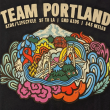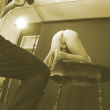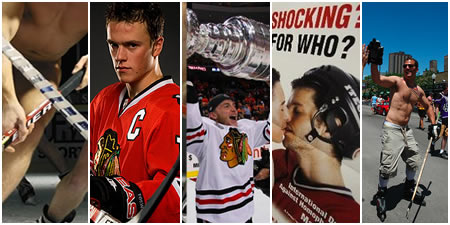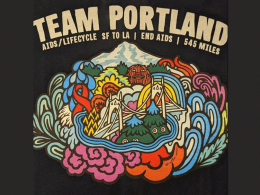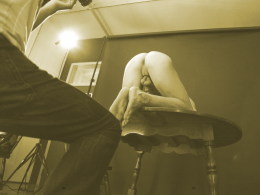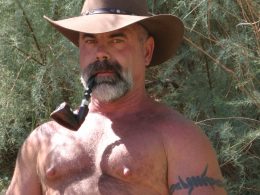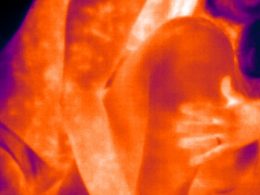Courtesy of Kevin Baxter for LATimes.
Early in Wade Davis’ first NFL training camp, in 2000, a teammate with the Tennessee Titans approached the rookie defensive back with some helpful advice. If you want to make the team, he whispered, stay away from people who are “different” — a code word Davis instantly knew referred to players suspected of being gay.
So that night Davis, who realized he was “different” during his sophomore year in high school, followed a group of teammates to a nearby strip club where he spent $1,500 to prove he was one of the guys. Yet despite the investment that night, the fear his secret would be discovered followed Davis from the Titans to similar, brief preseason stints with the Seattle Seahawks and Washington Redskins — even to two teams in NFL Europe.
“I would police my behavior,” says Davis, who grew up in Shreveport, La., attending services at a Southern Baptist church five times a week. “I would re-create a story that probably never even happened just to make guys think that I was as hyper-masculine as they were. I had kind of honed in on my skill of telling these fantastic lies.” It wasn’t until last June, eight years after injuries ended his football career, that the threat of ostracization subsided enough for Davis to end the lies and reveal his homosexuality outside a small circle of family and friends.
And it’s not hard to see why. Even though public opposition to same-sex marriage and gay rights is rapidly eroding, the locker rooms and clubhouses of the country’s four major sports leagues remain among the last bastions of homophobia in the U.S. Consider the numbers. About 4,000 players spent time on active rosters in the NBA, NHL, NFL and MLB in 2012. With the best estimates of the gay/bisexual population in U.S. ranging from 2% to 10%, it’s likely many of those 4,000 athletes are gay or bisexual. Yet not one has come out of the closet. Not this year, not last year, not ever.
There are openly gay congressmen and two senators-elect. There has been a gay governor and a cable TV network anchor. Just never an openly gay shortstop, quarterback or power forward. And changing that would require more than simply challenging convention. It could require a player to challenge his teammates as well. “It’s still taboo in the locker room,” explains the Clippers’ Grant Hill.
Like in the New England Patriots’ locker room. Earlier this season linebacker Brandon Spikes sent out a tweet claiming to be homophobic “just like I’m arachnophobic. I have nothing against homosexuals or spiders but I’d still scream if I found one in my bathtub.” Spikes later said he was joking. But former Angels outfielder Torii Hunter, among baseball’s most thoughtful and intelligent players, isn’t kidding when he says an “out” teammate could divide a team. “For me, as a Christian … I will be uncomfortable because in all my teachings and all my learning, biblically, it’s not right,” he says. “It will be difficult and uncomfortable.”
David Kopay (Redskins running back), Billy Bean (Dodgers and Padres outfielder) and John Amaechi (NBA center-forward) are gay athletes who waited, like Davis, to come out after their playing careers ended. Yet an active player coming out may be inevitable.
In the last six months Puerto Rican boxer Orlando Cruz, a featherweight contender, and Kevin McClatchy, former owner of the Pittsburgh Pirates, revealed they were homosexual. And hyper-masculine males such as Brendon Ayanbadejo of the Baltimore Ravens, Scott Fujita of the Cleveland Browns and Chris Kluwe of the Minnesota Vikings — all of whom are straight — have become impassioned spokesmen for same-sex marriage.
Then there’s NBA Commissioner David Stern, who last year said it’s no longer a matter of “if” but “when” basketball welcomes its first openly gay player. “It will happen,” he said. “I have no doubt about it.”
And talk like that, insists a cross section of professional athletes, former athletes, scouts and team executives, is laying the groundwork for a new locker room culture that will be more welcoming for gays. The views of older players, they say, are at odds with younger players, such as 26-year running back Arian Foster of the Houston Texans who, when asked this month about a gay player being in the NFL, told TV’s Jim Rome “People are more accepting of it…. I don’t think it will be long.”
As older players retire and younger ones take their place, attitudes in professional sports are bound to change. That generation gap in social thinking mirrors public opinion polls on gay marriage, with a CBS News poll released last month showing the greatest support — 72% — among Americans ages 18 to 29. But journalist Cyd Zeigler, co-founder of the gay sports website Outsports.com, says something else may be at work.
Zeigler interviewed more than two dozen current and former NFL players — including Redskins rookie Robert Griffin III, New England tight end Rob Gronkowski and Titans quarterback Matt Hasselbeck, plus retired Pro Bowlers Jevon Kearse, Ahman Green and Eddie George — over the last seven months and found just one who said he would be uncomfortable with a gay teammate. “When I talk to these guys, the majority of them have a gay family member. And all of them know at least one gay person,” Zeigler says.
Griffin had a gay teammate in high school, for example, Green has a gay brother and lesbian sister and Hasselbeck insists he must have played with at least one closeted teammate during his NFL career. In fact, as long as you’re not looking in the locker room, it isn’t hard to find sports figures who have close friends and family members who are gay.
NFL Commissioner Roger Goodell has a gay brother who has been in a committed relationship for 30 years. Paul Tagliabue, the man Goodell replaced, has a gay son and has won national recognition for work on gay issues, including last year’s donation of $1 million to create an assistance program at Georgetown University for lesbian, gay, bisexual and transgender students. “In the last 10 years [athletes] have become more exposed to it and they realize we’re not walking around with six arms and horns growing out of their head,” says Zeigler, who is gay.
So why hasn’t one active athlete in the four most prominent professional leagues come out? Blame the media, says Patrick Burke, a scout with the Philadelphia Flyers and the son of Toronto Maple Leafs General Manager Brian Burke. “The media likes to perpetuate this belief that … sports is this barbaric place full of dumb meathead jocks who are just waiting to jump on the first gay athlete they find,” says Patrick Burke who, to honor his late brother Brendan, has done much to break down that misperception.
Brendan Burke, who quit his high school hockey team in Massachusetts over fears his sexual orientation would be discovered, came out publicly while a sophomore at Ohio’s Miami University and called for tolerance for gays in professional sports. When he died in the winter of 2010 in an auto accident at age 21, the NHL rallied to his cause and that summer, in a groundbreaking gesture, the Chicago Blackhawks sent defenseman Brent Sopel and the team’s recently won Stanley Cup to the Chicago gay pride parade.
Patrick Burke took the campaign a big step further by founding the “You Can Play” project, which features NHL players — including the Kings’ Dustin Brown and Alec Martinez — plus players from two Major League Soccer teams in public service spots pushing the message that sexual orientation doesn’t matter. “If you can play,” the campaign insists in seven languages “you can play.”
The response has been overwhelming, says Patrick Burke, who says he knows of players in hockey and other sports who have told teammates they were gay without repercussions. But, he added, none are willing to take the next step and go public with their sexual orientation. “It’s impossible to really overstate how difficult it might be for an individual athlete to have the courage to come out,” Burke says. “The challenges and the fears are justified. They’re real.”
Just ask soccer player David Testo. When Testo, a decorated midfielder with the Montreal Impact of the second-tier North American Soccer League, came out on a Canadian TV show 13 months ago he said the initial reception was positive. But his contract had expired two weeks earlier and after his announcement the phone stopped ringing. Testo, 31, hasn’t played a game since.
“It seems like there is a lot more support these days. But for someone to come out to the public or just to their teammates, it takes a lot of just coming to terms with it yourself,” Testo says. “Most of these athletes are younger and they haven’t had their time to kind of explore and just come to that kind of self-awareness.
“I would love for someone to be able to do that in their prime and really be a role model, an inspiration for others. When that one special [player] does it, it’s just going to open the floodgates. But it’s hard. When there’s a lot of money on the line, when there’s endorsements on the line, it’s different. Why would anyone want to risk that?” Yet Testo is convinced he’s not the only professional athlete who is gay. “It can’t be,” he says. “It’s not possible. People have to do what they have to do for self-preservation.”
Which is why Burke, like the NBA’s Stern and the NFL’s Foster, remains convinced it’s only a matter of time before an active player comes out. And when that happens people will wonder what all the fuss was about. “People are going to be stunned by what a nonstory this is,” Patrick Burke says. “He’s going to walk into the [dressing] room, he going to tell his teammates he’s gay … and they’re all going to go, ‘Great. Suit up. We don’t care if you’re gay. Get out there and score a goal.’ “
